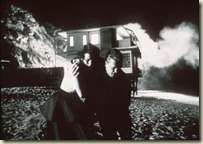 David Phillips, the president of the Royal Society of Chemistry, would like to share a theory with you:
David Phillips, the president of the Royal Society of Chemistry, would like to share a theory with you:
Prof. David Phillips says that Dr. No, with his personal nuclear reactor, helped to create a "remorselessly grim" reputation for atomic energy.
Why?
Prof. Phillips says the popularity of the Dr. No movie from 1962 created an enduringly negative image of nuclear power - as something dangerous that could be wielded by megalomaniacs with aspirations to world domination.
 I’d actually be surprised that people connect a James Bond villain to a serious view of nuclear energy. Do people remember that from Dr. No (1962) or the sight of Ursula Andress rising from the surf armed with shells. I vote for the latter.
I’d actually be surprised that people connect a James Bond villain to a serious view of nuclear energy. Do people remember that from Dr. No (1962) or the sight of Ursula Andress rising from the surf armed with shells. I vote for the latter.
---
 Nuclear energy has often been, in popular culture, if not exactly a fear engine in itself, the cause of fearful things. During the 1950s, this included a plethora of giant critters – ants, praying mantis’, grasshoppers - and bands of spies trying to export nuclear secrets. In the Mike Hammer movie Kiss Me Deadly (1955), our detective hero goes on the hunt for a box containing pure fission (whatever that might be) that has the capacity to destroy the world. How it got into the box and how you’d get it out safely and use it is not discussed.
Nuclear energy has often been, in popular culture, if not exactly a fear engine in itself, the cause of fearful things. During the 1950s, this included a plethora of giant critters – ants, praying mantis’, grasshoppers - and bands of spies trying to export nuclear secrets. In the Mike Hammer movie Kiss Me Deadly (1955), our detective hero goes on the hunt for a box containing pure fission (whatever that might be) that has the capacity to destroy the world. How it got into the box and how you’d get it out safely and use it is not discussed.
So by the time Dr. No came out in 1962, nuclear energy had long been established as what Alfred Hitchcock called the McGuffin – that is, the mechanism that got the plot rolling but wasn’t that important in itself. (Hitchcock himself used uranium-stuffed wine bottles as the McGuffin in Notorious (1946)).
---
But that’s enough belaboring. What Prof. Phillips is actually up to here is to use the 50th anniversary of Dr. No (and happily, Sean Connery and Ursula Andress are around to celebrate it, though sadly, not Joseph Wiseman, Dr. No himself) to make the point that nuclear energy should be freed of such associations:
"But the RSC asserts that nuclear power has to be part of the future national energy mix, in which it plays a major role, complemented by renewable sources. Fossil fuels have to be eradicated for people to live in a healthy environment."
"Let's say yes to nuclear and no to Dr. No's nonsense."
To be honest, while of course Prof. Phillips is absolutely correct on nuclear energy, the British Green Party’s view on Dr. No is also plausible:
This message [of Prof. Phillips] was not accepted by the Green Party - which argued that Bond movies reflected concerns rather than created them.
But is that really right?
---
 Consider: nuclear energy really isn’t that disliked, even in the shadow of Fukushima Daiichi, by Americans or Brits; the only movie I know of that uses a monster as a direct metaphor for nuclear energy is Godzilla (1954) – and who would quibble?; but most importantly, popular culture is always on the lookout for fearmakers – note that current end-of-the-world scenarios reference climate change (The Day After Tomorrow (2004)) or the earth itself rebelling (2012 (2009)).
Consider: nuclear energy really isn’t that disliked, even in the shadow of Fukushima Daiichi, by Americans or Brits; the only movie I know of that uses a monster as a direct metaphor for nuclear energy is Godzilla (1954) – and who would quibble?; but most importantly, popular culture is always on the lookout for fearmakers – note that current end-of-the-world scenarios reference climate change (The Day After Tomorrow (2004)) or the earth itself rebelling (2012 (2009)).
But sociologists need something to do and reading public anxieties into movies is always a ripe subject. But such speculation, fun as it can be, often doesn’t mean a thing.
From top to bottom: Joseph Wiseman, Ursula Andress, both from Dr. No; Ant and Joan Weldon from Them! (1954); Maxine Cooper and Ralph Meeker from Kiss Me Deadly (1955); the wine bottles from Notorious (1946); and Godzilla (1954). Oops, forgot one:
Sean Connery, from Dr. No.

Comments
The premise of the Fallout games is that you take the role of a person in a sort of Mad-Max lawless post-nuclear-apocalypse world.
Some things that jump out at me as being absurd about those games is that, for example, Fallout 3 is supposed to take place almost 200 years after the big war, and yet, no vegetation is growing anywhere, and radiation levels are still high. In reality, after 200 years, most of the radiation would be gone, and the world would be lush with plant life.
It's also a world portrayed as having lots of dangerous monsters roaming around the landscape as a result of genetic mutations, 2-headed livestock, etc. All pretty over-the-top stuff.
The thing is, I suspect a lot of people don't know better, and really think that is a somewhat realistic portrayal of what a world after some nuclear bombs went off, would be like.
Unfortunately, in pop culture, nuclear power and radiation are always far worse than they are in reality.